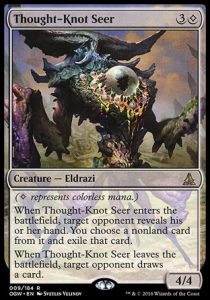“Who’s the Beatdown?” is a 1999 Magic article from by Mike Flores that introduced the ideas and terminology of the relative beatdown and control roles. The concepts are strongly relevant to other games (e.g. this OTC match) and still alive in Magic analysis today.
The heart of the article is:
The most common (yet subtle, yet disastrous) mistake I see in tournament Magic is the misassignment of who is the beatdown deck and who is the control deck in a similar deck vs. similar deck matchup. The player who misassigns himself is inevitably the loser.
In similar deck vs. similar deck matchups, there are a couple of things that you want to look at to figure out what role to play:
1. Who has more damage? Usually he has to be the beatdown deck.
2. Who has more removal? Usually he has to be the control deck.
3. Who has more permission and card drawing? Almost always he has to be the control deck.
If you are the beatdown deck, you have to kill your opponent faster than he can kill you. If you are the control deck, you have to weather the early beatdown and get into a position where you can gain card advantage.
Misassignment of Role = Game Loss.
Critically, Flores points out that even in a match between similarly fast aggressive decks or slow controlling decks, one of the two will be a bit more aggressive or more controlling than the other as a static gamestate element, via the cards each players put in their deck.
The beatdown (or aggro) should play aggressively in pursuit of a shorter and more resource-scarce tempo-oriented game. The plan is to force the opponent to deal with immediate threats and minimize the time and resources they can afford to use investing for later. When the op does invest resources towards non-immediate ends, the goal is to go for the throat and punish, reaching critical pressure before the investments yield returns.
The control should play defensively in pursuit of a longer and more resource-rich value-oriented game. The plan is to survive while preparing for the long term, turning the tables as the op runs out of steam. The goal is to fend off short-term defeat with as few resources as possible, investing with as much as the op’s pressure allows.
Use beatdown (aggro) vs control roles as a lens for thinking about other games. Correctly determining your relative role will let you make better choices, nudging the game in a direction that favors your setup.


